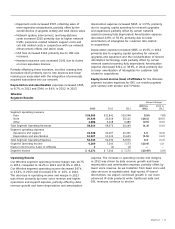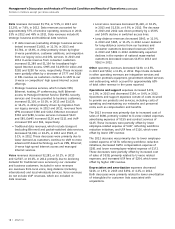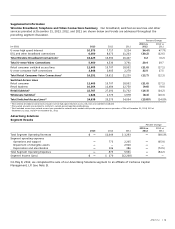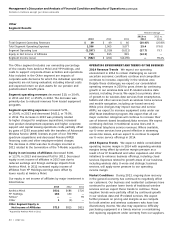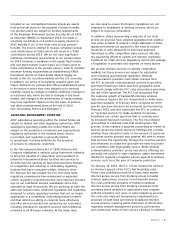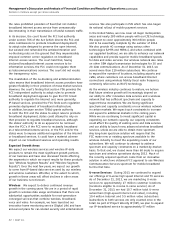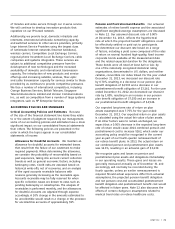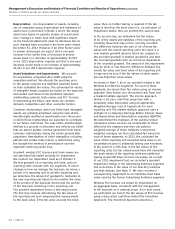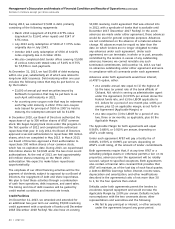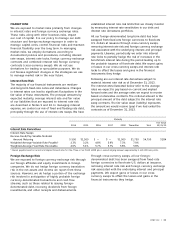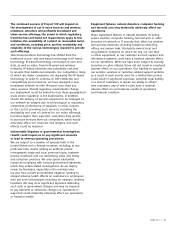AT&T Wireless 2013 Annual Report Download - page 29
Download and view the complete annual report
Please find page 29 of the 2013 AT&T Wireless annual report below. You can navigate through the pages in the report by either clicking on the pages listed below, or by using the keyword search tool below to find specific information within the annual report.
AT&T Inc. | 27
We review customer relationships and other long-
lived assets for impairment whenever events or
circumstances indicate that the carrying amount
may not be recoverable over the remaining life of
the asset or asset group. To determine that the asset
is recoverable, we verify that the expected undiscounted
future cash flows directly related to that asset exceed
its book value.
We evaluate our investments to determine whether
market declines are temporary and accordingly
reflected in accumulated other comprehensive income,
or other-than-temporary and recorded as an expense
in other income (expense) in the consolidated income
statements. This evaluation is based on the length of
time and the severity of decline in the investment’s
value. In 2012 and 2011, we identified an immaterial
other-than-temporary decline in the value of equity
method investments and various cost investments.
Income Taxes Our estimates of income taxes and
the significant items giving rise to the deferred assets
and liabilities are shown in Note 11 and reflect our
assessment of actual future taxes to be paid on
items reflected in the financial statements, giving
consideration to both timing and probability of these
estimates. Actual income taxes could vary from these
estimates due to future changes in income tax law
or the final review of our tax returns by federal, state
or foreign tax authorities.
We use our judgment to determine whether it is
more likely than not that we will sustain positions
that we have taken on tax returns and, if so, the
amount of benefit to initially recognize within our
financial statements. We regularly review our
uncertain tax positions and adjust our unrecognized
tax benefits (UTBs) in light of changes in facts and
circumstances, such as changes in tax law, interactions
with taxing authorities and developments in case law.
These adjustments to our UTBs may affect our income
tax expense. Settlement of uncertain tax positions may
require use of our cash.
OTHER BUSINESS MATTERS
Atlantic Tele-Network, Inc. Transaction In September
2013, we acquired Atlantic Tele-Network, Inc.’s U.S. retail
wireless operations, operated under the Alltel brand,
for $806 in cash, which included closing adjustments.
Under the terms of the agreement, we acquired wireless
properties, including licenses, network assets, retail stores
and approximately 550,000 subscribers. We expect to
complete network upgrades and migrate customers to
our network in the second half of 2014.
company initially owns only the wireless FCC licenses,
and then makes investments required to build an
operation comparable to the one that currently utilizes
the licenses. We utilized a 17-year discrete period to
isolate cash flows attributable to the licenses, including
modeling the hypothetical build-out. The projected cash
flows are based on certain financial factors, including
revenue growth rates, EBITDA margins and churn rates.
For impairment testing purposes, we assumed wireless
revenue growth to trend down from our 2013 growth
rate of 4.7% to a long-term growth rate that reflects
expected long-term inflation trends. We assumed
our churn rates will decline in 2014 from our rate
of 1.37% in 2013, in line with expected trends in the
industry but at a rate comparable with industry-leading
churn. EBITDA margins were assumed to continue to
trend at least 40%.
This model then incorporates cash flow assumptions
regarding investment in the network, development
of distribution channels and the subscriber base,
and other inputs for making the business operational.
We based the assumptions, which underlie the
development of the network, subscriber base and
other critical inputs of the discounted cash flow model,
on a combination of average marketplace participant
data and our historical results, trends and business
plans. We also used operating metrics such as capital
investment per subscriber, acquisition costs per
subscriber, minutes of use per subscriber, etc., to
develop the projected cash flows. Since we included
the cash flows associated with these other inputs
in the annual cash flow projections, the present value
of the unlevered free cash flows of the segment,
after investment in the network, subscribers, etc.,
is attributable to the wireless FCC licenses. The terminal
value of the segment, which incorporates an assumed
sustainable growth rate, is also discounted and is
likewise attributed to the licenses. We used a discount
rate of 8.5%, based on the optimal long-term capital
structure of a market participant and its associated cost
of debt and equity, to calculate the present value
of the projected cash flows. This discount rate is also
consistent with rates we use to calculate the present
value of the projected cash flows of licenses acquired
from third parties.
If either the projected rate of long-term growth of cash
flows or revenues declined by 1%, or if the discount
rate increased by 1%, the fair values of the wireless
FCC licenses, while less than currently projected, would
still be higher than the book value of the licenses.
The fair value of the licenses exceeded the book value
by more than 25%.


